Features and basic rules for the installation of an entrance gate

Wikipedia defines a gate as an opening in a wall or fence, which is locked with sections. The gate can be used to prohibit or to restrict access to any territory. Another option for their purpose is a decoration showing a passage, that is, in fact, an arch.
Everyone knows that the gate is installed as part of a fence or a wall., and it is also possible that they can completely replace the wall (for example, garage).
The gates serve to pass vehicles, thus, they can be designated as entry or exit.
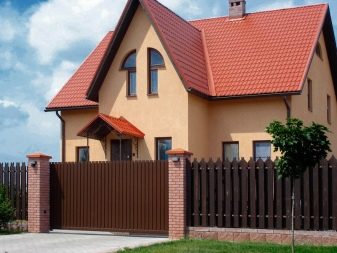
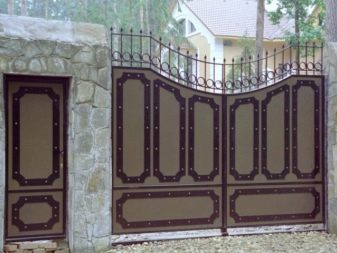
Views
The huge selection of options offered in our time for universal lifting, sliding, automatic and other designs, a wide range of types and types of plastic, metal, wood and automation that controls the gate, can often be confused when choosing them.
Perhaps today the most relevant is the subdivision into several types of gates.

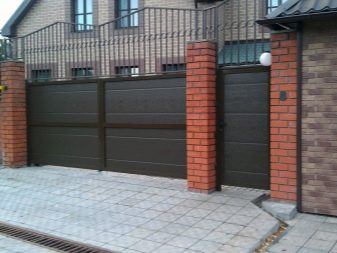
Recoil roller
Usage: industrial hangars and other buildings, summer cottages, country houses, estates.
Device: the sliding plane / sash itself, the support beam, the rollers-runners and the pillars-support.
Principle of operation: the leaf / sash, fixed on the bracket-beam, slides along the rollers.
In turn, gates are divided into two types:
- open (the guide is located at the bottom) - it is used for blind execution of gates and for gates with glazing, with the upper edge of any kind;
- closed (the guide is located on top) - applicable if increased aesthetic requirements are imposed on the appearance.
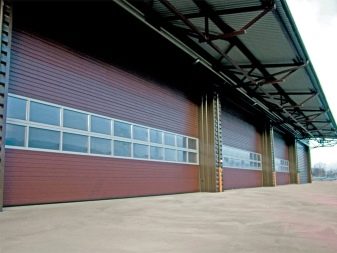
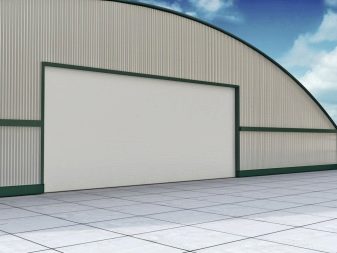
Pros:
- you can build a window or a wicket / door directly into the leaf / leaf of the gate;
- the opening is unlimited in height;
- the sashes require practically no space when opening / closing;
- burglary resistance;
- windproof.
Minuses:
- space is required for placing the sash in the extreme right / left position when the gate is opened to its maximum width;
- relatively expensive to acquire.
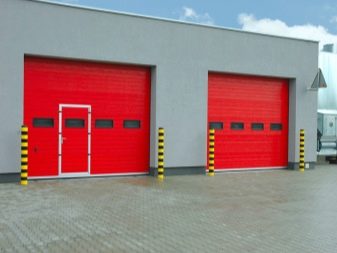
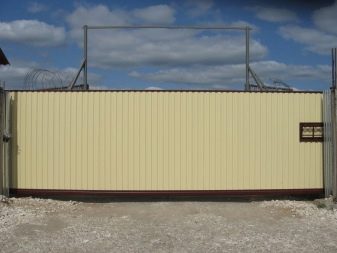
Swinging
Usage: private plots, industrial and social facilities, household buildings.
Device: hinged, double-leaf, supported on the hinges of metal, wooden or reinforced concrete pillars / bars.
Principle of operation: the collars turn on the hinges clockwise / counterclockwise.
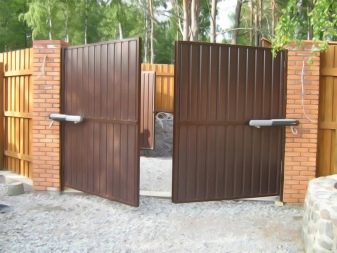
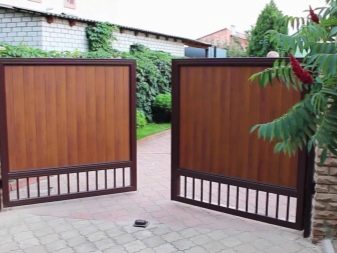
Pros:
- high availability;
- very easy to manufacture and mount;
- high protection against burglary;
- you can build a window or a wicket directly into the door leaf.
Minuses:
- sashes take up a lot of free space when opening / closing;
- sash can be damaged by strong wind;
- low burglar resistance.
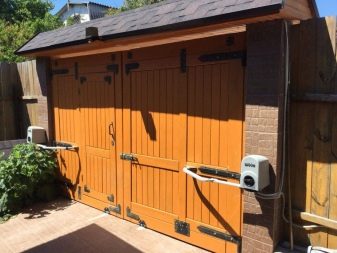

Roll
Usage: as temporary partitions / walls in shopping centers, enterprises, as light gates.
Design: narrow horizontal profiled lamellas, flexibly connected by long sides. The connected fragments are narrower than in sectional doors, so there is a possibility of using a shaft to raise / lower them.
Principle of operation: the leaf / sash rises along vertical iron guides and is wound on a shaft located in a protective box above the gate.
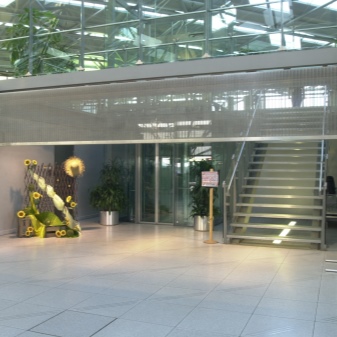

Pros:
- very convenient for rooms with low wall heights;
- very easy to mount and adjust later;
- a lot of useful internal space is released.
Minuses:
- relatively frequent breakdowns;
- low thermal insulation characteristics (many gaps in the leaf / leaf of the gate);
- high level of anti-theft performance.
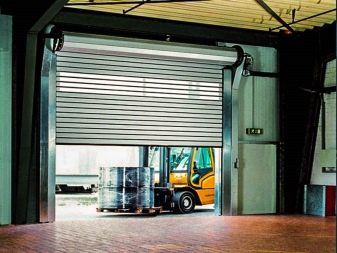
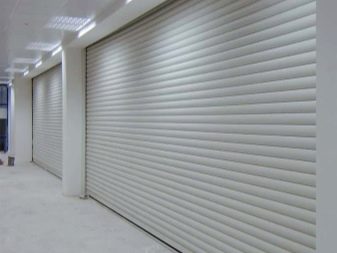
Sectional
Usage: used in large industrial and commercial buildings and structures due to the possibility of using and regulating large-sized doors for the passage of trains, oversized trucks, platforms and so on.
Device: sets of polyurethane foam (sandwich) sandwich panels of considerable thickness. In general, the leaf / sash has flexibility due to the fact that the panels are held together by hinged joints. They are hermetically sealed due to the use of heat and moisture resistant seals.
Principle of operation: the canvas slides along the guides with the help of rollers and is placed parallel to the ceiling under the ceiling.
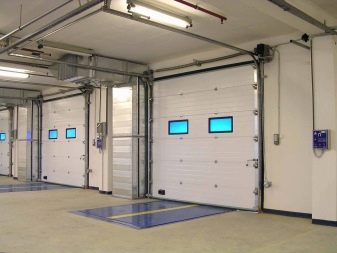
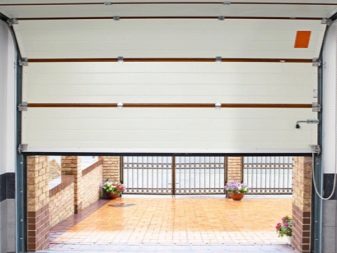
Pros:
- do not require free space near the opening;
- heat and wind resistant in these parameters are equal to a brick wall 30 cm thick;
- there are practically no restrictions in the choice of sizes;
- a window or a wicket can be built into the door leaf, if desired.
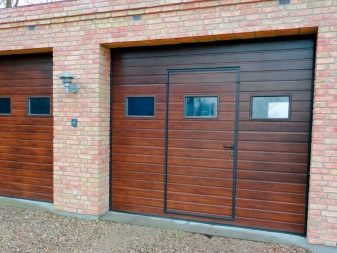
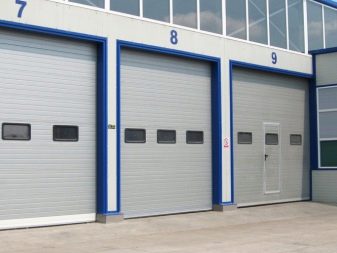
Minuses:
- require significant dimensions of the room for placing the canvas under the ceiling when the door is open;
- high price;
- difficult to install due to the large number of moving parts;
- require significant strength of the opening structures (concrete, or steel) due to their significant dead weight.
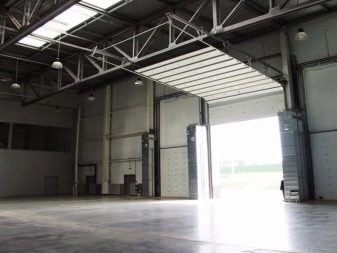

Installation instructions
The difference between the most popular types of swing and sliding gates today is visible to the naked eye - the first ones hold the palm due to the greater degree of simplicity of their model, installation and production. Meanwhile, creating a sliding / roller gate with your own hands, you can get many advantages over swing gates.
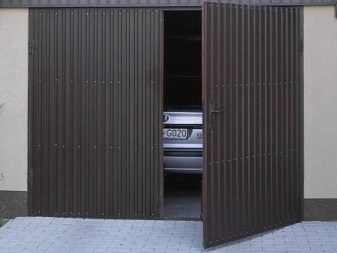
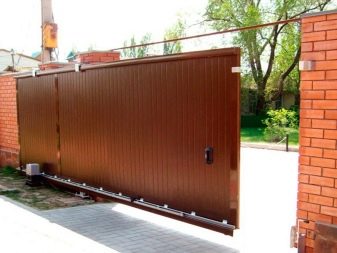
If you have decided to install sliding / roller gates yourself, we will focus on the installation and use of just such gates.
- Supports are installed, which are made of a channel, steel pipes, concrete, reinforced concrete, brick, timber bar. The level of freezing depth is taken for reliability equal to one meter in our latitudes. Accordingly, the work consists of digging a hole to a depth of 1 m or deeper, then the pillar installed in it is concreted.
The curing time of the concrete mixture is about 7 days.
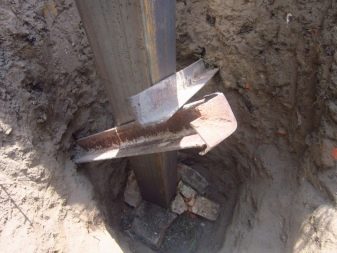

- The next stage is pouring the foundation. Most often, a channel beam is used from 16 to 20 cm in width and a steel bar, which is used as reinforcement, with an outer diameter of 10-14 mm. Sections of 1 thousand mm are made from it and welded to the channel shelves of the supports.
- A ditch is dug halfway between the supporting gate pillars. Dimensions 400x1500 mm deep, the channel is installed in the opposite way (shelves down) and poured with concrete. With a distance between the supports of 4 m, the length of the gate base will be 2 m.

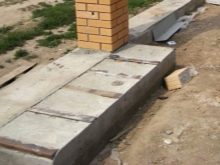
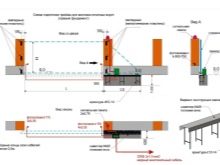
- The correct top surface of the channel must be flush with the coating surface to match the top surface of the subsequent coating. Subsequently, the carriage rollers are welded to this level area.
- The foundation is poured for at least a month, ideally.
- Frame pipes are subjected to degreasing and priming procedures, using a spray gun, brushes, sponges. Their diameter can be different, you can use what is at hand, which is more like it or cheaper. The outer frame is welded from this material.

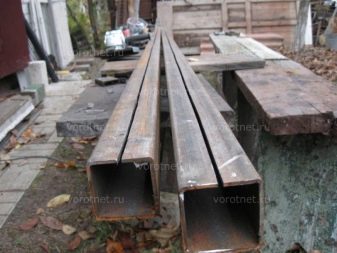
- Then the inner structure is assembled by welding. It will serve as a solid basis for fastening the cladding (corrugated board, siding). It is welded from a 20x20-40 mm pipe. The cladding joints are laid in such a way that they are joined to the lathing. Pipes are grabbed by 2 cm in increments of 20-30 cm. A guide is welded to the finished frame from below. Everything is staggered to avoid loss of shape.
- The next stage - it is recommended to clean the welded seams with a grinder and re-primer those parts where the integrity of the primer is broken.

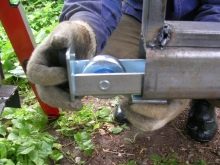
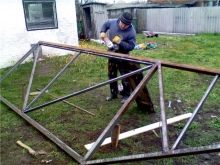
- When painting, it is recommended to apply at least two coats with intermediate drying.
- After complete drying of the pipes, the door frame proceeds to the sewing of the door leaf itself. Self-tapping screws or rivets are used as standard fasteners for sewing. For the least labor costs, it is advised to use improved self-tapping screws with a drill at the end and a drill. In this case, large expenditures in time will not be required.
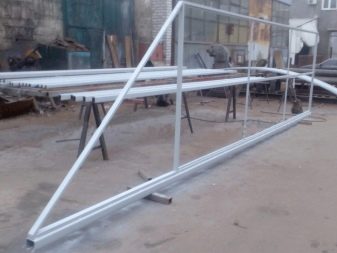
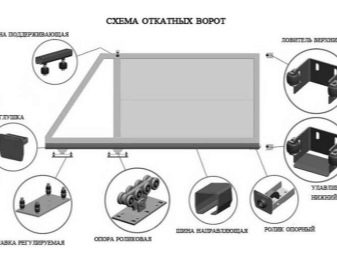
After complete hardening of the concrete, the base begins directly with the installation of the gate. First, rollers are welded to the channel of the gate foundation, placing them at the maximum possible distance. Do not forget that its diameter is approximately 150 mm, so the carriage closest to the opening is slightly pushed back.
Then the frame is installed on rollers, the gate is set using a level, and the trolley is tied to the channel. If there are inconsistencies, they are corrected, the gate is set again, upon reaching the desired result (position, absence of distortions, etc.), the carts are scalded.
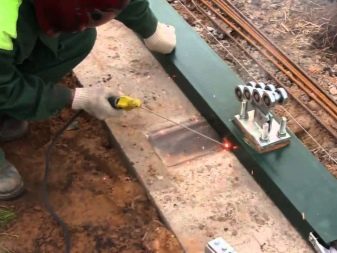
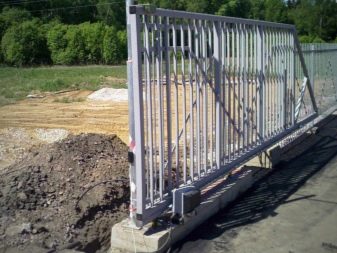
How to install by yourself?
Any installer will be able to mount and install swing gates in various ways independently. The classification can be made according to the installation and installation method. Accordingly, the service life depends on the method or method. Several characteristics and indicators are noted.
Today, swing gates sheathed with corrugated board are in the highest demand. They are mounted in dachas, in country estates, in plots. Before installation, you need to decide which material of pillars to give preference to for the sash canopy, since the entire workload will fall on them.
Poles for swing gates can be made of wood, reinforced concrete, or metal.
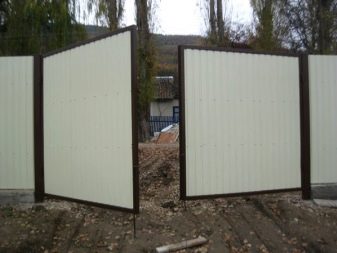

If swing gates are made of wood, they have a relatively low weight, the sashes are hung on metal pillars that hold the structure quite firmly, and there is also the possibility of replacing them.
The gates are mounted on metal posts with a section of 60 × 60, or 80 × 80 mm.
Useful life hack: not everyone understands the difference between the concepts of "pipe section" and "pipe diameter", hence many mistakes arise when using these two completely different, albeit interrelated concepts.
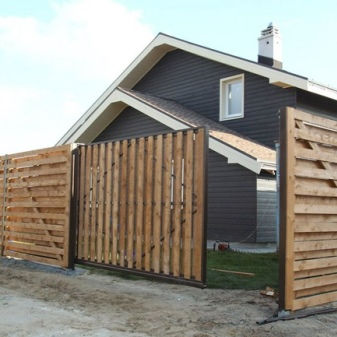
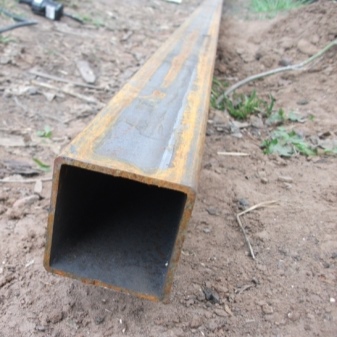
There is a formula for calculating the section.
If the support pipe is conventionally taken as a cylindrical figure, then in order to obtain the cross-sectional area, the classical planimetric formula for calculating the area of a circle is taken.
With the known outer diameter and wall thickness, the inner diameter is calculated:
S = π × R2, where:
- π - constant equal to 3.14;
- R is the radius;
- S is the cross-sectional area of the pipe for the inner diameter.
From here it is taken: S = π × (D / 2-N) 2, where:
- D - external section of the pipe;
- N is the wall thickness.
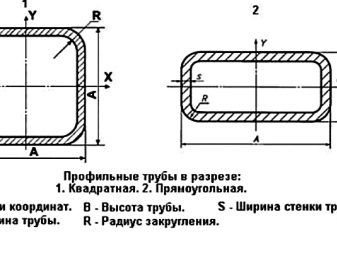

Hammering iron / metal / steel posts has several positive aspects.
The recommendations are as follows:
- profitable economically, because it does not require a long time;
- there is a possibility of their replacement and repair;
- poles can be installed by yourself.
- metal pillars are driven in 1.5 m, constantly checking the level;
- they are connected to each other with a temporary bar.
- sash frames are welded to them.

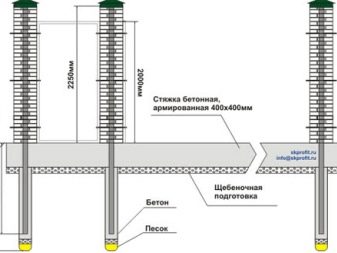
If the soil at the installation site is not suitable for simply driving the pipe into the ground, there is a way to further strengthen the base by using a reinforcement sleeve.
In this case:
- a hole is drilled at least 200 mm in diameter;
- additionally, for reinforcement, a so-called reinforcing glass is sometimes used;
- a support is placed in it, it is leveled;
- concrete is poured into the holes with a layer of 1.5 m deep.
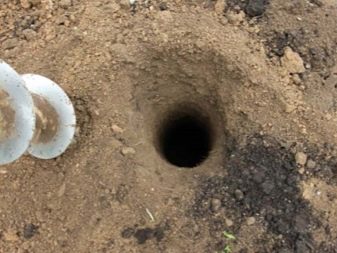

When hanging the sashes, a distance is left, since soil shift is not excluded, which can lead to a change in the position of the pillars. To prevent such displacement is possible only with the help of a frame that fixes the door frame along the entire perimeter, and this, in turn, can lead to inconveniences during operation, for example, to limit the height of the vehicle.
The next important point affecting the usability of the gate is the opening side of the sash, namely, in which direction the sashes will open.
To save space in the courtyard, it is customary for the gates to open outward.
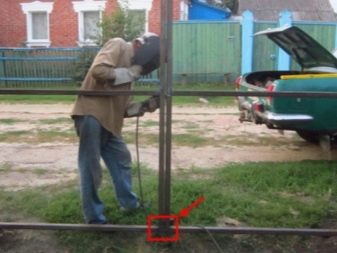
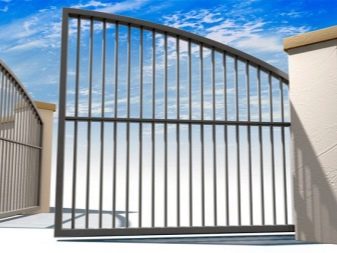
Structurally, swing gates are divided into two-leaf and single-leaf. And it also makes sense to embed a wicket into the sash, in this case you will not have to create a wicket separately, which will save time and materials.
From an aesthetic point of view, the choice of the external attractiveness of the gate is for the owner. The doors can be closed profiled sheet, openwork, forged.

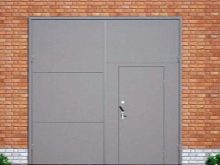
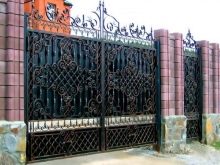
Automation
Advanced opening / closing systems using automation systems are widely used. This will apply to setting up almost any type of gate - swing, sliding, roll-up, sectional.

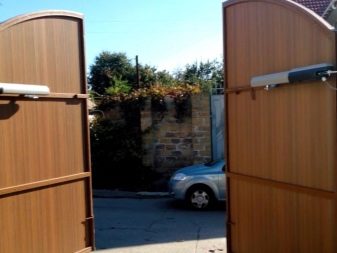
This is where electric drives can be very useful. If, in addition to the electric motor with the help of installation cables, a control unit, an antenna and an electromagnetic lock are installed, the automatic gates will turn into a completely modern complex. In addition, the undoubted convenience of automation lies in the fact that nowadays there is absolutely no need to get out of the car in the rain or snow, in the cold season or in the heat. It is enough to program the key fob and set the automatic gate system to its signal.
Conveniently, all these devices are powered from a standard 220V AC household power supply.


Peculiarities
Each type of gate has its own characteristics, which is due to the specifics of their scheme of use, on the one hand, and convenience, on the other.
For example, sectional doors will be more convenient than swing doors by saving free space at the bottom, but will require them to be installed parallel to the ceiling of a considerable depth in the garage or other room where they are used. They do not limit the width of the opening in which they are used. Rollers on ball bearings make it very easy to lift and lower the door leaf, especially if torsion springs are used.
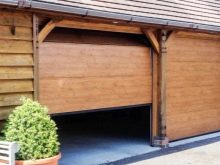
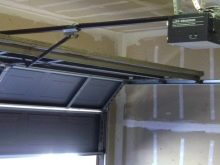
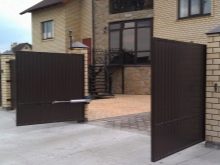
Sliding gates do not impose requirements on the height of the vehicles passing through them, but you will have to think about the distance to one side or the other from the opening in order to place the canvas / sash there in a fully open position.

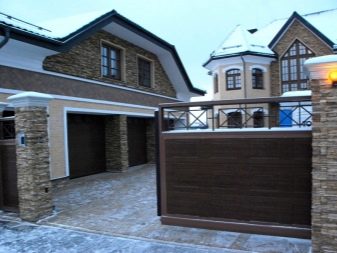
Manufacturers
Barriers, electric drives with modern laying of cable route nodes for various roller shutters, as well as roller shutters Came, Nice, Game have long and firmly gained popularity in the Russian market and are in great demand due to their reliable connection and high quality workmanship, as well as the ability to adjust and programming of remote control devices.

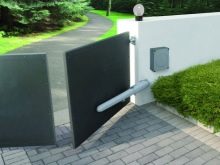
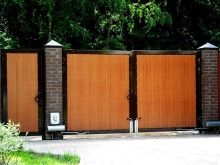
According to some reports, many companies are represented on the Russian market.producing leaves and mechanisms for the installation of sliding / sliding and sectional doors. At the moment, according to the results of surveys and marketing data, DoorHan (Russia) is in the conditional second place. First of all, this was achieved by low prices for high quality products that DoorHan can afford. The availability of spare parts on the Russian market can also be called a big advantage.
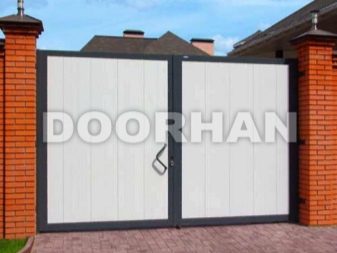
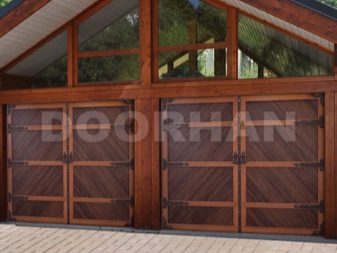
Of course, one cannot fail to mention the disadvantages of the manufacturer: low corrosion resistance and a small margin of safety. This leads to forced repairs and constant maintenance.
The high humidity and low temperatures prevailing in most of the territory of Russia do not make it possible to fully use the gates of this manufacturer, therefore they are recommended to be used mainly in the southern regions of our large country, where their functioning practically does not cause any complaints.
The first place was given by the respondents to Zaiger. This is one of the leaders of not only the Russian but also the European market.
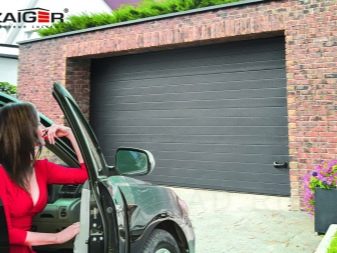

Successful examples and options
If you want to look at your summer cottage with different eyes, many do not know where to start. Experts recommend starting from the very beginning, like everything else.
Start over - change or make the shape and color of the gate and gate with your own hands. A homemade gray gate magically transforms into a magic door from Papa Carlo's closet or some kind of narnia stuck in his teeth.
First, you should choose the material from which such a miracle will be made.
For a summer residence, a tree, fiberboard / chipboard, professional sheet is quite suitable.
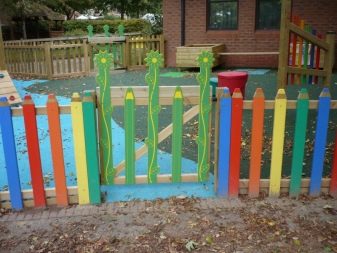
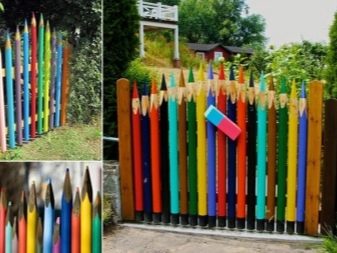
If the fence is stone, forged metal gates are best suited.
The size is chosen according to the size of the plot. Of course, for business purposes, a sufficient gate width is required for the passage of carts / tractors / trucks / bicycles.
The standard for wickets is wider than 1 m, and for gates wider than 2.6 m.
The gap above the ground should not be less than 20 cm. This is important because it is convenient to open the gate wings over the snow layer in winter.
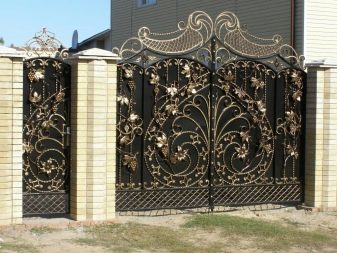
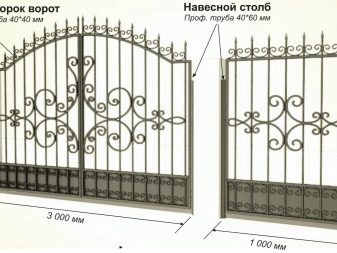
To paint a gate, you need to call on your imagination. Of course, when painting a gate made of colored pencils, the colors will differ greatly from the color gamut of the forged rods of the base of the gate.
It is necessary to carefully consider the organization of the space, free entry / entry and exit / exit. The human factor also plays a significant role, since not everyone likes publicity, and neighbors are usually curious.
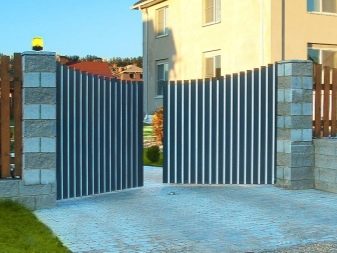
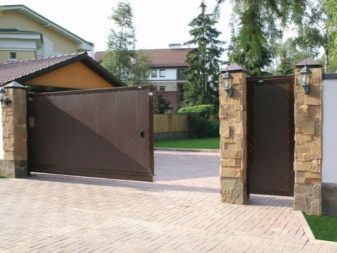
If the soil near the gate or gate is swampy, it will be necessary to take measures to strengthen the surface with sand, gravel, lay tiles or asphalt the site and paths.
Of course, wood lends itself to processing much easier than metal, but if you have a welding machine, the simplest locksmith tools, fittings, skilled hands and an assistant - nothing is impossible!
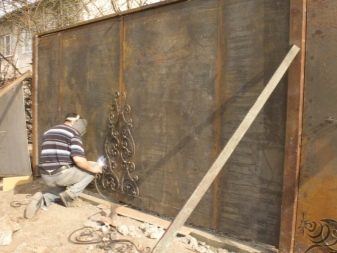
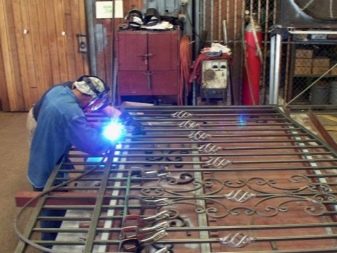
- Usually they start with a sketch. Sketch a drawing with preliminary dimensions, decide on the materials that you have in stock.
- It is necessary to start with the manufacture of the frame: an outer rectangle is assembled from a channel or pipe according to the intended dimensions. All parts are welded.
- Of course, when working with the welding unit, you should not neglect the rules of fire and personal safety: use a protective mask with a light filter, special clothing, shoes. If it is raining, outdoor welding is prohibited.

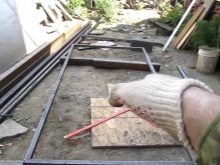

- The frame is sheathed using various materials: boards, metal sheets, plastic panels.
- The next step is awnings. Attachment points are marked on the frame and support, weld the hinges.
- At the end of the work, they are finishing the wicket - attaching handles, latches, padlock hinges, painting the canvas.
There is nothing easier than making a wooden gate!
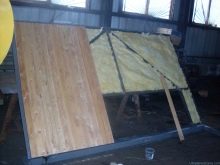

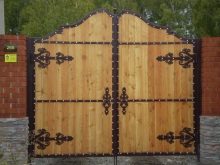
Quite often, after any work, wooden material remains, trimming boards, and so on, which are the best fit for the execution of a wonderful wicket or gate.
The sequence of actions will be approximately the same, except that a welding machine is not required, and the tools and fasteners will not be very different from those mentioned above.
Good luck!
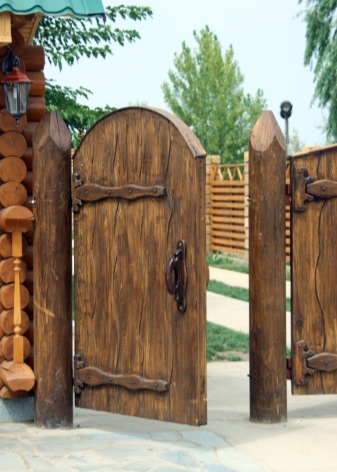
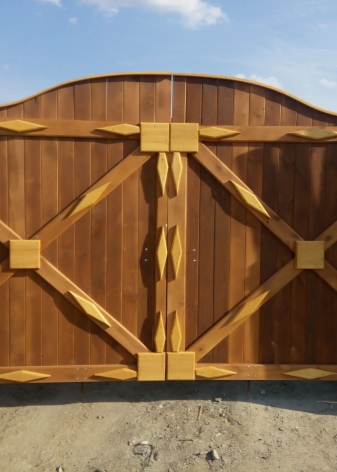
For information on how to make a forged gate with a wicket with your own hands, see the next video.



































































The comment was sent successfully.